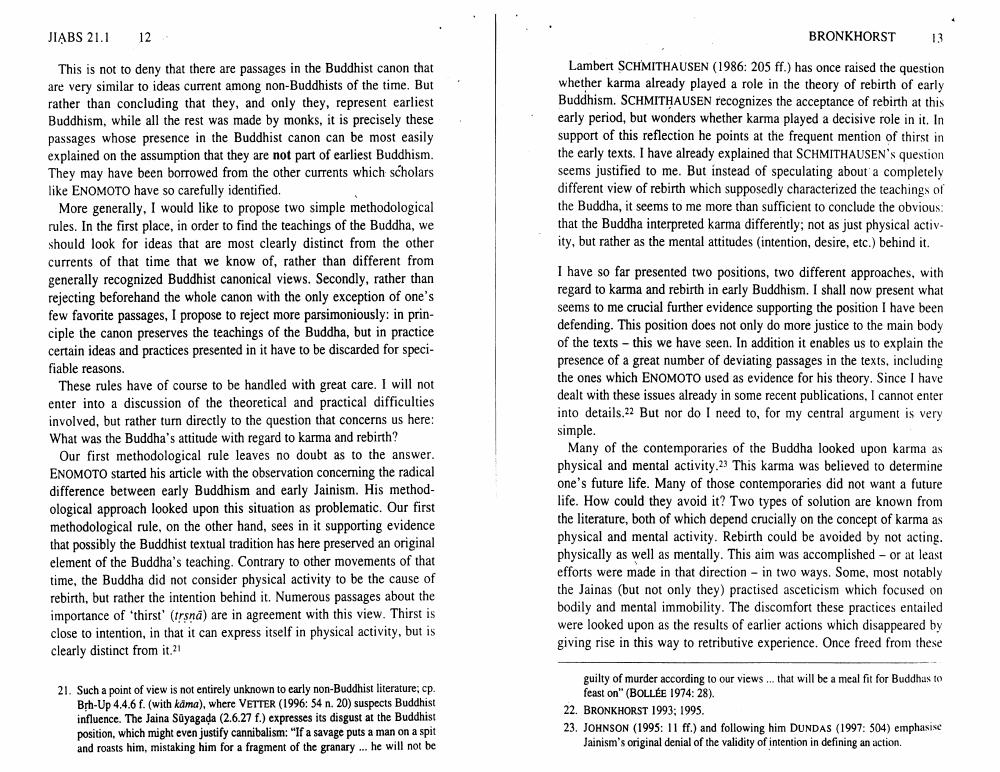Book Title: Did Buddha Believe In Karma And Rebirth Author(s): Johannes Bronkhorst Publisher: Johannes Bronkhorst View full book textPage 7
________________ JIABS 21.1 12 BRONKHORST 13 Lambert SCHMITHAUSEN (1986: 205 ff.) has once raised the question whether karma already played a role in the theory of rebirth of early Buddhism. SCHMITHAUSEN recognizes the acceptance of rebirth at this early period, but wonders whether karma played a decisive role in it. In support of this reflection he points at the frequent mention of thirst in the early texts. I have already explained that SCHMITHAUSEN's question seems justified to me. But instead of speculating about a completely different view of rebirth which supposedly characterized the teachings of the Buddha, it seems to me more than sufficient to conclude the obvious: that the Buddha interpreted karma differently, not as just physical activ. ity, but rather as the mental attitudes (intention, desire, etc.) behind it. This is not to deny that there are passages in the Buddhist canon that are very similar to ideas current among non-Buddhists of the time. But rather than concluding that they, and only they, represent earliest Buddhism, while all the rest was made by monks, it is precisely these passages whose presence in the Buddhist canon can be most easily explained on the assumption that they are not part of earliest Buddhism. They may have been borrowed from the other currents which scholars like ENOMOTO have so carefully identified. More generally, I would like to propose two simple methodological rules. In the first place, in order to find the teachings of the Buddha, we should look for ideas that are most clearly distinct from the other currents of that time that we know of, rather than different from generally recognized Buddhist canonical views. Secondly, rather than rejecting beforehand the whole canon with the only exception of one's few favorite passages, I propose to reject more parsimoniously. in principle the canon preserves the teachings of the Buddha, but in practice certain ideas and practices presented in it have to be discarded for specifiable reasons. These rules have of course to be handled with great care. I will not enter into a discussion of the theoretical and practical difficulties involved, but rather turn directly to the question that concerns us here: What was the Buddha's attitude with regard to karma and rebirth? Our first methodological rule leaves no doubt as to the answer. ENOMOTO started his article with the observation concerning the radical difference between early Buddhism and early Jainism. His method ological approach looked upon this situation as problematic. Our first methodological rule, on the other hand, sees in it supporting evidence that possibly the Buddhist textual tradition has here preserved an original element of the Buddha's teaching. Contrary to other movements of that time, the Buddha did not consider physical activity to be the cause of rebirth, but rather the intention behind it. Numerous passages about the importance of thirst' (trsnā) are in agreement with this view. Thirst is close to intention, in that it can express itself in physical activity, but is clearly distinct from it.21 I have so far presented two positions, two different approaches, with regard to karma and rebirth in early Buddhism. I shall now present what seems to me crucial further evidence supporting the position I have been defending. This position does not only do more justice to the main body of the texts - this we have seen. In addition it enables us to explain the presence of a great number of deviating passages in the texts, including the ones which ENOMOTO used as evidence for his theory. Since I have dealt with these issues already in some recent publications, I cannot enter into details.22 But nor do I need to, for my central argument is very simple. Many of the contemporaries of the Buddha looked upon karma as physical and mental activity.23 This karma was believed to determine one's future life. Many of those contemporaries did not want a future life. How could they avoid it? Two types of solution are known from the literature, both of which depend crucially on the concept of karma as physical and mental activity. Rebirth could be avoided by not acting. physically as well as mentally. This aim was accomplished - or at least efforts were made in that direction - in two ways. Some, most notably the Jainas (but not only they) practised asceticism which focused on bodily and mental immobility. The discomfort these practices entailed were looked upon as the results of earlier actions which disappeared by giving rise in this way to retributive experience. Once freed from these 21. Such a point of view is not entirely unknown to early non-Buddhist literature; cp. Brh-Up 4.4.6 f. (with kama), where VETTER (1996: 54 n. 20) suspects Buddhist influence. The Jaina Süyagada (2.6.27 f.) expresses its disgust at the Buddhist position, which might even justify cannibalism: "If a savage puts a man on a spit and roasts him, mistaking him for a fragment of the granary ... he will not be guilty of murder according to our views ... that will be a meal fit for Buddhas to feast on" (BOLLÉE 1974:28). 22. BRONKHORST 1993; 1995. 23. JOHNSON (1995: 11 ff.) and following him DUNDAS (1997: 504) emphasise Jainism's original denial of the validity of intention in defining an action.Page Navigation
1 ... 5 6 7 8 9 10
